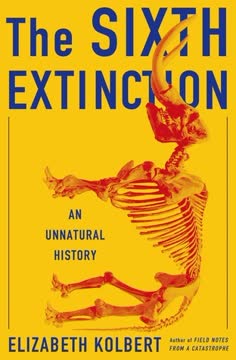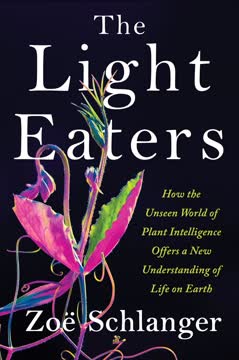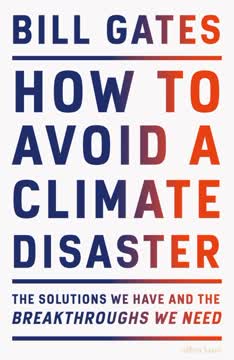Key Takeaways
1. Soil: The Forgotten Hero in the Fight Against Climate Change
The soil will save us.
Carbon sequestration potential. Soil has the remarkable ability to absorb and store vast amounts of carbon dioxide from the atmosphere. This process, known as carbon sequestration, could potentially mitigate the effects of climate change. Healthy soil, rich in organic matter, can store more carbon than the atmosphere and all plant life combined.
Soil degradation crisis. However, conventional agricultural practices have led to widespread soil degradation, releasing stored carbon back into the atmosphere. Over the past century, industrial farming techniques have depleted soil organic matter, reduced biodiversity, and increased erosion. This not only contributes to climate change but also threatens food security and ecosystem health.
Soil restoration as a solution. By adopting practices that restore soil health, we can reverse this trend and harness soil's potential as a carbon sink. These practices include:
- No-till farming
- Cover cropping
- Crop rotation
- Composting
- Holistic grazing management
2. The Intricate Dance of Plants and Soil Microorganisms
Plants leak. And in doing so, they support another world entirely: The world under our feet; the dark kingdom of which we're astoundingly unaware.
Symbiotic relationships. Plants and soil microorganisms have evolved a sophisticated trading network over millennia. Plants provide carbon-rich exudates through their roots, feeding the soil microbes. In return, these microorganisms deliver essential nutrients to the plants and help build soil structure.
Soil food web. This underground ecosystem is incredibly diverse and complex:
- A teaspoon of healthy soil contains billions of microorganisms
- These include bacteria, fungi, protozoa, nematodes, and microarthropods
- Each plays a crucial role in nutrient cycling, water retention, and carbon storage
Impact on plant health. The health of this soil food web directly affects plant growth and resilience. Plants grown in biologically active soils are:
- More resistant to pests and diseases
- Better able to withstand drought and other stresses
- More nutritious for humans and animals
3. Holistic Management: Revolutionizing Agriculture and Ranching
Nature did it right for millions of years until we came and boogered things up.
Mimicking nature. Holistic management, developed by Allan Savory, aims to mimic natural processes in agriculture and ranching. This approach recognizes that ecosystems evolved with large herds of grazing animals, which played a crucial role in maintaining grassland health.
Key principles:
- Planned grazing: Moving livestock frequently to prevent overgrazing
- Animal impact: Using hoof action to break soil crusts and incorporate organic matter
- Rest periods: Allowing plants sufficient time to recover between grazing events
Benefits of holistic management:
- Increased soil organic matter and carbon sequestration
- Improved water retention and drought resistance
- Enhanced biodiversity
- Increased productivity and profitability for farmers and ranchers
4. No-Till Farming and Cover Crops: Building Soil Health Naturally
We're basically on top of an immense sand dune here.
No-till revolution. Conventional tilling disrupts soil structure and releases stored carbon. No-till farming, by contrast, leaves the soil undisturbed, preserving its structure and biology. This practice:
- Reduces erosion by up to 90%
- Increases water infiltration and retention
- Promotes carbon sequestration
- Saves time and fuel costs for farmers
Cover crop benefits. Planting cover crops during fallow periods or between cash crops provides numerous advantages:
- Protects soil from erosion
- Adds organic matter to the soil
- Suppresses weeds naturally
- Fixes nitrogen (for legume cover crops)
- Improves soil structure and water retention
Synergistic effects. Combining no-till with cover cropping creates a powerful system for building soil health. Farmers like Gabe Brown have demonstrated that these practices can:
- Eliminate or greatly reduce the need for synthetic fertilizers and pesticides
- Increase profits by lowering input costs
- Improve crop yields and resilience to extreme weather events
5. The Carbon Farming Revolution: Turning Soil into a Carbon Sink
Given what we've seen in our experiments, one and a half tons is doable.
Carbon farming potential. Carbon farming refers to agricultural practices that remove carbon dioxide from the atmosphere and store it in the soil. Research suggests that widespread adoption of these practices could sequester billions of tons of carbon annually.
Key carbon farming practices:
- No-till agriculture
- Cover cropping and crop rotation
- Compost application
- Agroforestry and silvopasture
- Managed grazing
Economic incentives. Governments and private markets are beginning to recognize the value of soil carbon sequestration:
- Australia's Carbon Farming Initiative
- California's cap-and-trade program
- Voluntary carbon offset markets
These programs provide financial incentives for farmers and ranchers to adopt carbon-sequestering practices, potentially creating a new income stream for agricultural producers.
6. Rethinking Agricultural Policy and Research Priorities
We still operate out of the cultural meme that we humans are superior to everything else in nature, that we're the big-brain mammals and that we can always come up with the technology that's going to be superior to anything nature does.
Policy misalignment. Current agricultural policies often incentivize practices that degrade soil health and contribute to climate change. Subsidies for commodity crops, crop insurance programs, and research funding priorities need to be realigned to support regenerative agriculture.
Research gaps. Despite the potential of soil health practices, research funding has been limited. Key areas needing more attention include:
- Long-term studies on carbon sequestration in different ecosystems
- Economic analyses of regenerative farming systems
- Development of region-specific best practices for soil health
Education and extension. There is a critical need to bridge the gap between soil health research and on-farm implementation. This requires:
- Strengthening agricultural extension services
- Developing farmer-to-farmer learning networks
- Incorporating soil health principles into agricultural education programs
7. Bridging the Gap Between Environmentalists and Agriculturalists
If we had been sitting at the same table 10 years ago, we would have been on opposite ends. And we'd have been sitting there because one of us was suing the other.
Historical conflict. Environmentalists and agriculturalists have often been at odds, viewing each other with suspicion and mistrust. This divide has hindered progress on crucial issues like soil health and climate change mitigation.
Finding common ground. Recent years have seen a growing recognition of shared interests between these groups:
- Both want to protect and enhance the land's productivity
- Both recognize the threat of climate change to agriculture and ecosystems
- Both seek to promote practices that support wildlife and biodiversity
Collaborative initiatives. Partnerships between environmental organizations and agricultural groups are becoming more common:
- The California Rangeland Conservation Coalition
- The Malpai Borderlands Group
- The Nature Conservancy's work with ranchers and farmers
These collaborations demonstrate the potential for win-win solutions that benefit both agriculture and the environment.
8. Urban Soil Health: The Unexpected Frontier
There is a lot of soil functioning in urban areas, and, to me, that's a really positive message.
Urban soil potential. While often overlooked, urban soils play a crucial role in ecosystem health and carbon sequestration. Research shows that only 20% of urban landscapes are truly impervious, leaving significant potential for soil improvement.
Benefits of healthy urban soils:
- Improved stormwater management and flood prevention
- Reduced urban heat island effect
- Enhanced biodiversity and wildlife habitat
- Increased carbon sequestration
- Improved air and water quality
Urban soil health strategies:
- Green infrastructure (e.g., bioswales, rain gardens)
- Urban tree planting and maintenance
- Community gardens and urban agriculture
- Composting programs
- Reduced use of chemical fertilizers and pesticides
By focusing on urban soil health, cities can contribute significantly to climate change mitigation while improving quality of life for residents.
Last updated:
FAQ
1. What is "The Soil Will Save Us" by Kristin Ohlson about?
- Soil as Climate Solution: The book explores how healthy soil, managed by scientists, farmers, and foodies, can play a crucial role in reversing climate change by sequestering carbon.
- Underground Microbial World: Ohlson delves into the complex world of soil microorganisms and their symbiotic relationship with plants, which is essential for soil fertility and carbon storage.
- Regenerative Agriculture: The narrative highlights innovative agricultural practices—like no-till farming, cover cropping, and holistic grazing—that restore soil health and ecosystem balance.
- Personal and Global Stories: Through personal anecdotes and global case studies, the author illustrates the transformative potential of working with, rather than against, nature.
2. Why should I read "The Soil Will Save Us" by Kristin Ohlson?
- Hopeful Climate Perspective: The book offers a rare, optimistic approach to climate change, focusing on practical, nature-based solutions rather than doom and gloom.
- Accessible Science: Ohlson translates complex soil science into engaging stories, making the subject approachable for non-experts.
- Actionable Insights: Readers gain practical ideas for supporting or implementing regenerative agriculture, whether as consumers, gardeners, or policymakers.
- Broader Implications: The book connects soil health to food quality, water management, biodiversity, and even economic opportunities, showing its relevance to everyone.
3. What are the key takeaways from "The Soil Will Save Us" by Kristin Ohlson?
- Soil as Carbon Sink: Healthy soil can absorb and store vast amounts of atmospheric carbon, helping to mitigate global warming.
- Microbial Partnerships: The partnership between plants and soil microbes is fundamental to soil fertility, water retention, and ecosystem resilience.
- Regenerative Practices Work: Techniques like no-till farming, cover crops, holistic grazing, and composting can rapidly rebuild soil health and productivity.
- Systemic Change Needed: Policy, economic incentives, and public awareness must shift to support regenerative agriculture on a large scale.
4. How does "The Soil Will Save Us" by Kristin Ohlson explain the connection between soil and climate change?
- Carbon Cycle Disruption: The book explains that conventional agriculture and land misuse have released massive amounts of soil carbon into the atmosphere, contributing to climate change.
- Photosynthesis and Sequestration: Plants pull carbon dioxide from the air and, through their roots and microbial partners, store it in the soil as organic matter.
- Soil as a Solution: Ohlson argues that restoring soil carbon is a scalable, safe, and cost-effective way to draw down excess atmospheric CO2.
- Scientific Support: The book features leading soil scientists, like Rattan Lal, who quantify the potential of soil to sequester billions of tons of carbon annually.
5. What are the main regenerative agriculture methods discussed in "The Soil Will Save Us" by Kristin Ohlson?
- No-Till Farming: Avoiding plowing preserves soil structure, protects soil carbon, and supports microbial life.
- Cover Cropping: Planting diverse crops year-round keeps living roots in the soil, feeding microbes and preventing erosion.
- Holistic Grazing: Managed livestock mimic natural herd movements, trampling plant matter into the soil and stimulating regrowth and carbon storage.
- Composting and Organic Inputs: Adding compost and organic matter boosts microbial activity and soil fertility without synthetic chemicals.
6. What role do soil microorganisms play according to "The Soil Will Save Us" by Kristin Ohlson?
- Nutrient Cycling: Microbes break down organic matter, making nutrients available to plants in exchange for carbon-rich root exudates.
- Soil Structure Creation: Bacteria and fungi build soil aggregates, improving water retention, aeration, and resistance to erosion.
- Plant Protection: Beneficial microbes form protective barriers around roots, outcompeting pathogens and supporting plant health.
- Carbon Storage: Microbial processes transform plant carbon into stable soil organic matter, locking it away for decades or centuries.
7. How does "The Soil Will Save Us" by Kristin Ohlson address the challenges of conventional agriculture?
- Soil Degradation: The book details how plowing, monocultures, and chemical inputs destroy soil structure, deplete organic matter, and harm microbial life.
- Water Issues: Compacted, lifeless soils lead to poor water infiltration, increased runoff, and greater vulnerability to droughts and floods.
- Nutrient Loss: Reliance on synthetic fertilizers disrupts natural nutrient cycles and leads to pollution and dead zones in waterways.
- Economic and Policy Barriers: Ohlson discusses how subsidies, research funding, and market forces often favor destructive practices over regenerative ones.
8. What is holistic planned grazing, and how is it presented in "The Soil Will Save Us" by Kristin Ohlson?
- Mimicking Nature: Holistic planned grazing involves moving livestock in patterns that replicate wild herds, preventing overgrazing and promoting plant recovery.
- Soil Restoration: The trampling and manure from dense, short-term grazing stimulate plant growth, increase soil organic matter, and enhance water retention.
- Case Studies: The book profiles Allan Savory and ranchers in Zimbabwe and the U.S. who have reversed desertification and revived rivers using this method.
- Controversy and Evidence: While some scientists debate the data, Ohlson presents compelling on-the-ground results and explains the challenges of conventional research in complex systems.
9. How does "The Soil Will Save Us" by Kristin Ohlson discuss the economic and policy aspects of soil carbon sequestration?
- Carbon Markets: The book explores efforts in Australia and the U.S. to pay farmers for building soil carbon, including the challenges of measurement and permanence.
- Ecosystem Services: Ohlson highlights the broader public benefits of healthy soils—clean water, flood prevention, biodiversity—and argues for public investment.
- Barriers to Adoption: Issues like short-term land leases, lack of research funding, and entrenched subsidies for conventional agriculture slow progress.
- Innovative Incentives: Examples include government grants, private investment funds, and voluntary carbon markets supporting regenerative practices.
10. What are the main obstacles to wider adoption of regenerative agriculture, according to "The Soil Will Save Us" by Kristin Ohlson?
- Lack of Awareness: Many farmers, policymakers, and the public are unaware of the science and benefits of soil health.
- Research Funding Gaps: Most agricultural research is funded by industry and focuses on conventional methods, leaving regenerative practices under-studied.
- Policy and Subsidy Misalignment: Government programs often incentivize monocultures, chemical use, and crop insurance for risky practices.
- Cultural and Economic Inertia: Farmers face financial risks in transitioning, and the current system rewards scale and short-term yields over long-term resilience.
11. What are some of the most memorable quotes from "The Soil Will Save Us" by Kristin Ohlson, and what do they mean?
- "The soil will save us." – This encapsulates the book’s central thesis: that restoring soil health is a powerful, hopeful solution to environmental crises.
- "Nature did it right for millions of years until we came and boogered things up." – Rancher Greg Judy’s quip highlights the wisdom of working with natural systems rather than against them.
- "We can learn from our mistakes if we’re open." – Allan Savory’s reflection on the importance of humility and adaptability in land management.
- "If we get out of the way, nature will do most of the work." – Rick Haney’s insight into the self-healing potential of ecosystems when given the chance.
12. How can individuals and communities apply the lessons from "The Soil Will Save Us" by Kristin Ohlson?
- Support Regenerative Farmers: Choose food from producers who use no-till, cover crops, holistic grazing, and organic practices.
- Garden for Soil Health: Apply compost, avoid synthetic chemicals, plant diverse species, and keep soil covered year-round.
- Advocate for Policy Change: Engage with local and national policymakers to support research, incentives, and programs that promote soil health.
- Educate and Share: Spread awareness about the importance of soil, the role of microbes, and the potential for climate and ecosystem restoration through regenerative agriculture.
Review Summary
The Soil Will Save Us by Kristin Ohlson explores how regenerative farming practices can improve soil health, increase crop yields, and combat climate change through carbon sequestration. Readers appreciate the book's optimistic tone and accessible explanations of complex soil science concepts. While some criticize the lack of scientific rigor, many find it an eye-opening introduction to sustainable agriculture. The book highlights innovative farmers and researchers working to restore soil health, challenging conventional farming methods and offering hope for environmental restoration.
Similar Books







Download PDF
Download EPUB
.epub digital book format is ideal for reading ebooks on phones, tablets, and e-readers.




